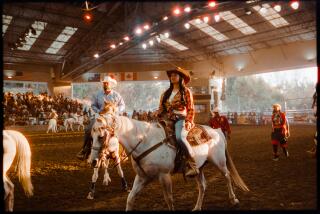Roundup of Cavalry Unit Is on Horizon : World War II: The first reunion of all-black regiment at Camp Lockett is scheduled for this week. The nation’s last horse cavalry patrolled the Mexican border.
- Share via
Assembling the troops was easier in the old days.
All you had to do was to send a man in knee-high riding boots and a Smokey the Bear-style campaign hat to the top of Bugler’s Rock to sound the call. Before the last note echoed off the nearby hills, 5,000 horsemen would respond by lining up at attention.
That’s the way it was 50 years ago when an all-black regiment of soldiers gathered 120 miles south of Los Angeles to create America’s last horse cavalry.
Fred Jones could use a bugle as he helps organize a reunion this week of troopers who were assigned to the long-forgotten cavalry camp.
“This is going to be the first reunion--and, I’m afraid, the last,” said Jones, 68, now a Los Angeles County court deputy. “We’re getting old.”
About 50 of the former cavalrymen assigned during World War II to Camp Lockett near Campo, Calif., have signed up for the reunion. In the parlance of range-riding horsemen, Jones wants to round up the strays.
Camp Lockett was an unusual place. But then, the horse cavalry was an unusual outfit for World War II.
America was just a few days from being drawn into the war when officials decided to turn 700 acres of leased cattle ranchland at Campo, about 35 miles east of San Diego and just north of the Mexican border, into a military base made of equal parts barracks and stables.
The horse cavalry would patrol the border to prevent any invasion by Japanese sneaking in through Mexico, officials decided. At the same time, troopers would train for possible mountain combat in the French Alps.
The U.S. Army was segregated at the time. But all-black cavalry units had long been a fixture in the West, where they patrolled the frontier from Montana to Texas in the late 19th Century.
The Indians they fought dubbed them the “Buffalo Soldiers.” The name stuck in 1898 when black troopers served with the Rough Riders in Cuba and went into Mexico in 1916 in pursuit of Pancho Villa.
But cavalry recruits in 1941 were a raw bunch, remembers Hollis Ellis, 84. Ellis had joined the mounted military in 1927 and was a master sergeant at Camp Lockett. That made him one of the highest-ranking blacks on the base.
“I was from Texas and I enjoyed riding and jumping and training horses,” said Ellis, a retired Los Angeles school facilities manager. “It was quite a shock for most of them to find themselves on a horse for eight hours a day.”
Remembers Jones: “I was a city boy. The only horse I’d even seen was a milkman’s horse in Cincinnati where I grew up.”
The Camp Lockett troopers learned to rise at dawn and feed and clean their horses before eating breakfast themselves. They learned to ride in close formation. Finally, they learned to ride at a full gallop in attack formation across the roughest terrain that Campo had to offer. They carried carbines and machine guns on their horses.
Army films made at the time look like Hollywood cowboy-and-Indian movies--except for the heavy steel Army helmets that the troopers wore when training for battle. The distinctive felt-brimmed campaign hats were worn for inspections and other camp activities.
Deep down inside, however, most of the Buffalo Soldiers knew their days at Camp Lockett were something of a wartime fantasy.
“Horses just didn’t fit in the mechanized Army. But we looked good. We were sharp. I admit that,” shrugs Ellis.
“What a waste, to train for something they weren’t going to really use,” Jones agrees.
In 1944, the Camp Lockett troopers were shipped to Casablanca, Morocco. Their horses stayed behind. The era of the horse cavalry was over.
Camp Lockett was later used as a prisoner-of-war camp for captured Italian soldiers and as a postwar convalescent hospital for wounded American GIs.
Although Buffalo Soldiers have had periodic reunions over the years, a gathering of Camp Lockett veterans has never been attempted, said Jim Hinds, an Alpine, Calif., military historian who has spent more than a year helping organize this week’s event.
“Fifty is a good turnout,” he said. “Fifty years is a long time. Two of those who had planned to come have died during the past year.”
Hinds said last-minute, $85 registrations for the reunion will be accepted Friday afternoon at the old stone Campo General Store on California 94. The store is now operated as a museum by the Mountain Empire Historical Society.
Returning troopers will ride restored railroad cars and view one of Camp Lockett’s original stables, several surviving Army warehouses and a tiny shrine built by Italian prisoners of war.
And in the center of the old camp, across from where the regimental headquarters stood, they’ll see Bugler’s Rock.
More to Read
Sign up for Essential California
The most important California stories and recommendations in your inbox every morning.
You may occasionally receive promotional content from the Los Angeles Times.














